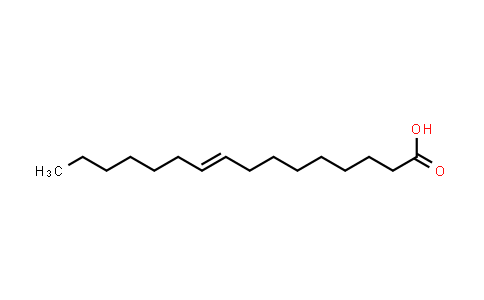
Palmitelaidic Acid NLT 98%
Product Number : MC500533
CAS Number : 10030-73-6
Molecular Formula : C16H30O2 | Molecular Weight : 254.41
Synonyms : 9-trans-Hexadecenoic acid;trans-Palmitoleic acid
Quote Request| Purity | NLT 98% |
|---|---|
| Storage | at 20ºC 2 years |
| MolCore specializes in manufacturing high-purity CAS No.10030-73-6, Palmitelaidic Acid with the molecular formula C16H30O2 and molecular weight 254.41 delivering critical API intermediates for global pharmaceutical and research industries, certified under ISO quality systems. | |
* The above information is for reference only.
| Chemical Name | Palmitelaidic Acid |
|---|---|
| CAS Number | 10030-73-6 |
| MDL Number | MFCD00067230 |
| Molecular Formula | C16H30O2 |
| Molecular Weight | 254.41 |
| Synonyms | 9-trans-Hexadecenoic acid;trans-Palmitoleic acid |
Palmitelaidic Acid (9-trans-Hexadecenoic acid) is the trans isomer of palmitoleic acid. Palmitoleic acid is one of the most abundant fatty acids in serum and tissue. IC50 & Target: AMPK, PPARα, Glucokinase[2] In Vitro: The monounsaturated fatty acid palmitoleate (palmitoleic acid) is one of the most abundant fatty acids in serum and tissues, particularly adipose tissue and liver. Its endogenous production by stearoyl-CoA desaturase 1 gives rise to its cis isoform, cis-palmitoleate. Palmitoleic acid has been correlated with multiple cardiometabolic risk factors, including high blood pressure, total cholesterol, TGs, apoA-I, apoB, and endothelial dysfunction[1]. In Vivo: Palmitoleic acid promotes a faster uptake of glucose in the body, associated with higher insulin concentration. Palmitoleic acid increases the phosphorylation of AMPK, up-regulates glucokinase and down-regulates SREBP-1. Regarding AMPK downstream, palmitoleic acid increases the production of FGF-21 and stimulates the expression of PPARα[2]. Palmitoleic acid reduces body weight increase, ameliorates the development of hyperglycemia and hypertriglyceridemia, and improves insulin sensitivity. Furthermore, palmitoleic acid down-regulates mRNA expressions of proinflammatory adipocytokine genes (TNFα and resistin) in white adipose tissue and lipogenic genes (SREBP-1, FAS, and SCD-1) in liver[3].
© Copyright 2015-2025 Hangzhou MolCore BioPharmatech Co.,Ltd. All rights reserved.
